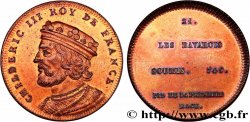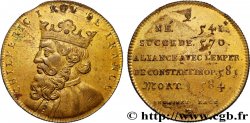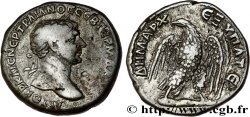E-auction 657-679209 - METALLIC SERIES OF THE KINGS OF FRANCE Médaille, Charlemagne - 23 - refrappe ultra-moderne
You must signin and be an approved bidder to bid, LOGIN TO BID. Accounts are subject to approval and the approval process takes place within 48 hours. Do not wait until the day a sale closes to register. Clicking on « bid » constitutes acceptance of the terms of use of cgb.fr private e-auctions.
Bids must be placed in whole Euro amounts only. The sale will start closing at the time stated on the item description; any bids received at the site after the closing time will not be executed. Transmission times may vary and bids could be rejected if you wait until the last second. For further information ckeck the E-auctions F.A.Q.
NO BUYER'S FEE.
NO BUYER'S FEE.
Type : Médaille, Charlemagne - 23 - refrappe ultra-moderne
Date: n.d.
Metal : silver plated bronze
Diameter : 34 mm
Orientation dies : 12 h.
Weight : 20,86 g.
Edge : cannelée
Puncheon : corne d’abondance
Coments on the condition:
Patine hétérogène avec des traces de rayures et de manipulation
Obverse
Obverse legend : CHARLEMAGNE ROY DE FRANCE.
Obverse description : Buste imaginaire lauré, cuirassé et drapé à gauche.
Reverse
Reverse legend : 23. / NÉ. 742. / SUCCEDE. 768. / COURONNÉ EMPEREUR / D’OCCIDENT. 800. / MORT. 814. / SECONDE RACE. / P..
Reverse description : Légende en 8 lignes et corne d’abondance à l’exergue.
Commentary
Médaille conservée sous capsule. Refrappe ultra-moderne des séries de jetons.
Charles Ier, dit le Grand ou Charlemagne (en latin Carolus Magnus, en allemand Karl der Große), est né le 2 avril, probablement en 742 ou 748, sans certitude quant au lieu de naissance. Il est mort à Aix-la-Chapelle le 28 janvier 814. Il est roi des Francs (768-814), devient par conquête roi des Lombards (774-814) et est couronné empereur par le pape Léon III le 25 décembre 800, relevant une dignité prestigieuse disparue depuis l'an 476 en Occident.
Monarque guerrier, il agrandit notablement son royaume par une série de campagnes successives, en particulier par la lente mais néanmoins violente soumission des Saxons païens (772-804). Souverain réformateur, soucieux d'orthodoxie religieuse et de culture, il protège les arts et les lettres et est à l'origine de la « renaissance carolingienne ».
Son œuvre politique immédiate ne lui survit pas longtemps. Respectueux de la tradition germanique en matière successorale, Charlemagne avait prévu le partage de l'Empire entre ses trois fils dès 806. L'empire ne sera finalement partagé entre ses trois petits-fils qu'au traité de Verdun en 843. Le morcellement féodal des siècles suivants, puis la division de l'Europe en États-Nations rivaux condamnent à l'impuissance ceux qui tentent explicitement de restaurer l'empire universel de Charlemagne, en particulier les souverains du Saint-Empire romain germanique, d'Otton Ier en 962 à Charles Quint au XVIe siècle, ou encore Napoléon Ier, hanté par l'exemple du plus éminent des Carolingiens.
Pour la suite de sa biographie, voir http://fr.wikipedia.org/wiki/Charlemagne.
Medal preserved in a capsule. Ultra-modern re-minting of token series.
Charles I, known as the Great or Charlemagne (in Latin Carolus Magnus, in German Karl der Große), was born on April 2, probably in 742 or 748, without certainty as to the place of birth. He died in Aix-la-Chapelle on January 28, 814. He was king of the Franks (768-814), became king of the Lombards by conquest (774-814) and was crowned emperor by Pope Leo III on December 25, 800, reviving a prestigious dignity that had disappeared in the West since the year 476..
A warrior monarch, he significantly expanded his kingdom through a series of successive campaigns, in particular through the slow but nevertheless violent subjugation of the pagan Saxons (772-804). A reforming sovereign, concerned with religious orthodoxy and culture, he protected the arts and literature and was at the origin of the \\\"Carolingian renaissance\\\".
His immediate political work did not long outlive him.. Respectful of the Germanic tradition in matters of succession, Charlemagne had planned the division of the Empire between his three sons from 806. The empire was finally divided between his three grandsons only at the Treaty of Verdun in 843.. The feudal fragmentation of the following centuries, then the division of Europe into rival nation-states, condemned to impotence those who explicitly attempted to restore the universal empire of Charlemagne, in particular the sovereigns of the Holy Roman Empire, from Otto I in 962 to Charles V in the 16th century, or even Napoleon I, haunted by the example of the most eminent of the Carolingians..
For the rest of his biography, see http://fr. Wikipedia. org/wiki/Charlemagne
Charles Ier, dit le Grand ou Charlemagne (en latin Carolus Magnus, en allemand Karl der Große), est né le 2 avril, probablement en 742 ou 748, sans certitude quant au lieu de naissance. Il est mort à Aix-la-Chapelle le 28 janvier 814. Il est roi des Francs (768-814), devient par conquête roi des Lombards (774-814) et est couronné empereur par le pape Léon III le 25 décembre 800, relevant une dignité prestigieuse disparue depuis l'an 476 en Occident.
Monarque guerrier, il agrandit notablement son royaume par une série de campagnes successives, en particulier par la lente mais néanmoins violente soumission des Saxons païens (772-804). Souverain réformateur, soucieux d'orthodoxie religieuse et de culture, il protège les arts et les lettres et est à l'origine de la « renaissance carolingienne ».
Son œuvre politique immédiate ne lui survit pas longtemps. Respectueux de la tradition germanique en matière successorale, Charlemagne avait prévu le partage de l'Empire entre ses trois fils dès 806. L'empire ne sera finalement partagé entre ses trois petits-fils qu'au traité de Verdun en 843. Le morcellement féodal des siècles suivants, puis la division de l'Europe en États-Nations rivaux condamnent à l'impuissance ceux qui tentent explicitement de restaurer l'empire universel de Charlemagne, en particulier les souverains du Saint-Empire romain germanique, d'Otton Ier en 962 à Charles Quint au XVIe siècle, ou encore Napoléon Ier, hanté par l'exemple du plus éminent des Carolingiens.
Pour la suite de sa biographie, voir http://fr.wikipedia.org/wiki/Charlemagne.
Medal preserved in a capsule. Ultra-modern re-minting of token series.
Charles I, known as the Great or Charlemagne (in Latin Carolus Magnus, in German Karl der Große), was born on April 2, probably in 742 or 748, without certainty as to the place of birth. He died in Aix-la-Chapelle on January 28, 814. He was king of the Franks (768-814), became king of the Lombards by conquest (774-814) and was crowned emperor by Pope Leo III on December 25, 800, reviving a prestigious dignity that had disappeared in the West since the year 476..
A warrior monarch, he significantly expanded his kingdom through a series of successive campaigns, in particular through the slow but nevertheless violent subjugation of the pagan Saxons (772-804). A reforming sovereign, concerned with religious orthodoxy and culture, he protected the arts and literature and was at the origin of the \\\"Carolingian renaissance\\\".
His immediate political work did not long outlive him.. Respectful of the Germanic tradition in matters of succession, Charlemagne had planned the division of the Empire between his three sons from 806. The empire was finally divided between his three grandsons only at the Treaty of Verdun in 843.. The feudal fragmentation of the following centuries, then the division of Europe into rival nation-states, condemned to impotence those who explicitly attempted to restore the universal empire of Charlemagne, in particular the sovereigns of the Holy Roman Empire, from Otto I in 962 to Charles V in the 16th century, or even Napoleon I, haunted by the example of the most eminent of the Carolingians..
For the rest of his biography, see http://fr. Wikipedia. org/wiki/Charlemagne








 Report a mistake
Report a mistake Print the page
Print the page Share my selection
Share my selection Ask a question
Ask a question Consign / sell
Consign / sell
 Full data
Full data















